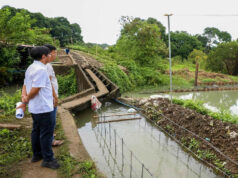THE P165-billion Bayanihan to Recover as One legislation is not expected to be sufficient for sustaining workers and companies through the pandemic, according to think tank IBON Foundation, Inc.
“The Philippine economy will lose as much as P1.9 trillion in 2020 because of the pandemic-driven economic crisis… But the Duterte administration’s Bayanihan to Recover as One Act, or Bayanihan II, is worth just P165.5 billion,” independent development institution IBON said in a statement Thursday.
It noted that the cash subsidies of P5,000 to P8,000 per month would put recipients below the poverty threshold.
“Only P19.2 billion is budgeted for cash subsidies and other assistance which is just 3.8 million beneficiaries at most. The aid will also just be a mere P37-60 per person per day for a month or even less than the official poverty threshold,” IBON Foundation said.
It estimates that up to 27 million Filipinos are currently either jobless or suffered from reduced income due to the lockdown, which accounts for 60% of the labor force.
Unemployment eased to 10% in July from the peak of 17.7% in April, according to official data.
It said the P77-billion budget allocation for production and enterprise support will cover “a small fraction of workers” employed by micro, small and medium-sized enterprises, including some farmers and fisherfolk.
Bayanihan II allots P140 billion in funding and P25 in standby appropriations in which funding will be authorized once revenue is available. The bill has been passed and ratified by Congress and is now awaiting President Rodrigo R. Duterte’s signature.
Economic managers have been stressing the need to keep funds in reserve in case of a prolonged pandemic.
“While we know that economic recovery is not going to be a sprint, we do have the fiscal stamina for running this marathon. It is to our own advantage to keep our deficit within manageable limits so we can continue to access financing at terms that are favorable to the Filipino people. We therefore thank the House and Senate bicameral committee for approving a fiscally responsible Bayanihan II,” Finance Secretary Carlos G. Dominguez III said in a speech last week.
The proposed measure is the government’s main form of stimulus for an economy that contracted 16.5% in the second quarter. Officials now estimate a contraction of up to 6.6% in 2020.
The University of Asia and the Pacific (UA&P) and the First Metro Investment Corp. (FMIC) in the August issue of their joint “Market Call” report has called the bottom on the economy, saying it sees government spending propping up growth in the second half.
They said government spending for infrastructure and health “should (maintain) its fast pace” in the second half to mitigate the economic downturn.
UA&P and FMIC expect the slump in the third-quarter GDP (gross domestic product) to ease into a single-digit decline, with that of the fourth quarter expected to improve further as quarantine rules are eased.
“With the relaxation of strict quarantine measures in mid-August, the economic recovery may gain traction by Q4 although some headwinds still swirl — COVID-19 cases remain elevated, although death rates remain low, public transportation still mostly absent in Metro Manila, more US-China friction and among others,” according to the report, issued Thursday.
Metro Manila is now under general community quarantine.
“We begin to see month-on-month gains in the real economy, such as in manufacturing, capital goods imports, exports, and probably construction and expect to see more in the coming months, albeit at non-spectacular rates,” UA&P and FMIC said. — Beatrice M. Laforga



